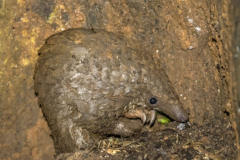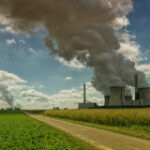- The oil palm tree is native to one of the largest contiguous blocks of lowland rainforest in West Africa, and provides food and habitat for many animals, including threatened species.
- Grown in agroforestry plots in concert with other plants, it’s been a subsistence crop for generations in Liberia, where it’s known as “country palm.”
- Initial field data from the Sustainable Oil Palm in West Africa (SOPWA) Project finds country palm plots have higher levels of plant species diversity compared to monoculture oil palm production systems.
- As Liberia rolls out plans to scale up its domestic palm oil production, conservationists and community leaders are calling for community-based country palm farming to be enshrined as a cornerstone of the country’s palm oil future — and not replaced by industrial, monoculture plantations.
Across southeastern Liberia, oil palms grow wild in the forest. Known as “country palm,” the Elaeis guineensis tree is native to West Africa and treasured by local communities.
“In the rural areas where there are palms in the wild, if you want to farm in those areas people will say to you, ‘Do not cut down the palm trees!’” says James Otto, program coordinator at the Sustainable Development Initiative, an environmental and community rights NGO based in Liberia. “The palm is usable by everybody, it’s not one person to a palm tree.”
Harvesting the fruit is traditionally a communal effort, and it’s manually processed into cooking oil and butter that’s then used in almost every dish, along with multiple other household and medicinal purposes. Selling products made from country palm at the local market has long been a source of income for subsistence farmers.
“I remember my grandfather doing that,” Otto says. “But it is not only for livelihood purposes, it has a serious tie with our culture, with our way of life.”

He cites the example of traditional leaders visiting from other parts of Liberia where there was no wild palm to obtain and bring back seeds, “so they would germinate in their own land areas, so it’s a key tradition for the people of Liberia.”
Wild oil palm is not only beneficial for communities, but for birds and mammals too; it’s native to one of the largest contiguous blocks of lowland rainforest in West Africa, “so there are a lot of important species of conservation concern in those areas,” says Ben Freeman, a conservation biologist at the University of Liberia.
“One of the most endangered bird species [in the region] is the Timneh parrot [Psittacus timneh], which feeds on oil palm a lot, as well as hornbills,” he says. “[E]ven pangolins make use of the palm trees for their habitats, so it is a key part of the ecosystem.”

Despite native oil palm’s longstanding presence in Liberia’s forests and traditional communities, there’s been little research into its use. However, the social and ecological value of country palm farming is now being quantified as part of the Sustainable Oil Palm in West Africa (SOPWA) Project, a collaboration between the University of Liberia and the University of Cambridge in the U.K.
Based in Sinoe county, the project is comparing old-growth forest with country palm farming plots and industrial plantations owned by industry giant Golden Veroleum Liberia, one of the largest oil palm companies in Liberia, to measure the relative biodiversity and survey the ecosystems within each land use type.
“There was no comprehensive research program that was looking at the whole ecosystem impacts of oil palm production in Africa,” says SOPWA Project coordinator Michael Pashkevich. This is needed, he says, as most of the understanding of the environmental impacts of oil palm has so far been based on large-scale and smallholder monoculture plantations in Southeast Asia.
Commercial oil palm production has been expanding in West Africa in recent decades, as corporations from Southeast Asia have sought new territory to establish plantations, but the context in this region is “really ecologically and culturally different,” Pashkevich says.
The deeply rooted relationship between country palm farming and the forest is embedded in these differences, and Pashkevich says this could offer a completely different way of thinking about the oil palm crop that has become synonymous with environmental destruction.
“At a basic level, country palm is in a state of natural regeneration, as farmers rotate cultivation across the landscape, ensuring that it is never at such a rate that it’s going to threaten the rainforest permanently over time, which makes it very sustainable,” he says.

Country palm cultivation is part of the shifting agriculture system, with farmers rotating crops such as rice and cassava over areas of land and burning them at the end of the dry season. They don’t cut down the old palms when they plant new crops, because they’re beneficial to the community. And besides, the trees are fire tolerant, so withstand the burning process, says Freeman, who’s also the in-country coordinator for the SOPWA Project.
“Most of the local population are involved in farming, but the primary objective is not oil palm farming,” he says. “[T]hey farm for rice and other food products, and eventually the natural regeneration that takes place includes oil palm.”
The general pattern from the field study data, so far, is that country palm sits somewhere in between rainforest and industrial palm in terms of the types of species that it hosts and their relative abundance.
“So, if the rainforest is an actual system, country palm is this secondary regenerating rainforest and then you have this highly modified system, so it represents this nice middle ground,” Pashkevich says.
Unsurprisingly, the field data show that country palm plots have higher levels of plant species diversity compared to monoculture oil palm production systems.
“In our plant survey we found 22 species in our country palm across all of our plots, so that accounts for about a third of the total species that we found in the rainforest and that’s within a relatively small 50x50m [164×164-foot] plot,” Pashkevich says.
SOPWA also found that country palm settings also remain cooler than industrial oil palm plantations when daytime temperatures peak. This is when habitat changes have the greatest impact on ecosystems through influences in microclimate, according to a 2024 paper published by SOPWA researchers in Science of The Total Environment.
From a biodiversity perspective, a cooler environment means the species assemblages of country palm plots are more likely to resemble those of rainforests, Pashkevich says.
“For many animals and plants, the microclimate is really important and not just in terms of where they prefer to inhabit, but it can be really critical in a heatwave where they can take refuge,” he says. “[S]o it’s important for biodiversity because a change will also predict changes in ecosystem functioning as well.”

These insights into country palm could also provide “a very nice source of ideas from West Africa, in ways to mitigate some of the ecological impacts of production,” Pashkevich adds.
This could mean advances in multispecies agroforestry design and the value of having a more diverse understory in industrial oil palm plantations, he suggests.
Although the definition is in flux, regenerative agriculture strategies such as these are gaining traction in Indonesia and Malaysia where large-scale experiments within commercial plantations are showing promising results for how they can improve biodiversity and ecosystem functions, reduce the need for chemical inputs, as well as boost crop resilience to climate change.
“Thinking of the application of wild harvested oil palm as part of diversified agroforestry systems and trying to understand more about the diversity of the species and associated management practices could be a really promising contribution to regenerative agriculture and restoration,” says Rachael Garrett, professor of conservation and development at the University of Cambridge.
From a management perspective, another finding coming out of the SOPWA Project is the importance of retaining rainforest around industrial plantations to support restoration.
“The country palm system works well alongside the industrial oil palm plantations in southeast Liberia because they are still surrounded by large amounts of rainforest, including high carbon value and high carbon stock conserved forest,” Pa





